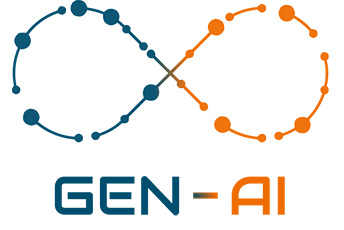Banking and Finance (Banks, Insurers, Fintechs)
Scenario:
In the banking and financial sector, institutions manage large volumes of scanned documents, such as invoices, bank statements, credit documents, or mortgages. Manually reviewing these documents to extract key information, such as amounts, dates, interest rates, and legal terms, can be a tedious and error-prone process. By combining the power of a multimodal chatbot with a semantic extractor based on OCR + Computer Vision + LLM, the automated processing of these documents is significantly streamlined and optimized.
How the Integration Works in the Banking and Financial Sector:
- Multimodal Interaction with the Chatbot:
○ Bank employees, insurers, or financial analysts interact with the chatbot in different ways:
■ Text: Querying details of invoices or bank statements.
■ Images: Uploading scanned images of financial documents, such as invoices, mortgage contracts, or bank statements.
■ Audio: Uploading recordings of conversations or verbal inquiries about financial products.
- Processing Financial Documents:
○ OCR: The multimodal chatbot uses OCR to convert images of invoices, bank statements, or scanned contracts into readable text. This includes capturing key details such as account numbers, amounts, due dates, and interest rates.
○ Computer Vision: Analyzes the structure of the financial document to visually identify tables, headers, bank or insurer logos, and other design elements that may influence the document’s analysis and classification.
○ LLM (Large Language Model): Once the text is extracted, the LLM interprets the financial content. This allows the analysis of credit or mortgage contract terms, automatic calculations based on extracted data (e.g., calculating outstanding amounts or accumulated interest rates), and structuring the information in a useful way for users.
- Information Extraction and Analysis:
○ The system can automatically extract key data from invoices or bank statements:
■ Amounts to be paid.
■ Due dates.
■ Details of interest rates or credit terms.
○ In credit or mortgage documents, the LLM can interpret complex clauses, facilitating the understanding of the terms for financial analysts or customers.
- Real-Time Response and Automation:
○ Text: The chatbot can provide financial summaries or answer specific questions like “What is the outstanding amount on this invoice?” or “What is the interest rate on this mortgage contract?”
○ Images: In the case of visual documents (such as bank statements), the system can highlight key areas, such as the total payable or important dates, directly on the image.
○ Audio: Users can ask verbal questions and receive automated real-time responses, improving the service experience.
Advantages of Integration in the Banking and Financial Sector:
- Automation of Financial Processes:
○ The system automates the processing of large volumes of financial documents, eliminating the need for manual review and speeding up the data analysis and verification cycle.
○ It allows for the quick extraction of critical information, such as amounts and dates, which employees can use to make immediate decisions.
- Greater Accuracy in Handling Complex Documents:
○ With the combination of OCR, Computer Vision, and LLM, the accurate capture of information is ensured even in complex financial documents that include tables, graphs, or multiple columns of data.
○ The analysis of financial contracts is also more precise, as the LLM can interpret legal and financial clauses in their proper context.
- Employee Time Optimization:
○ Banking and financial employees no longer need to spend time manually reviewing lengthy documents. The chatbot can perform this task automatically, presenting only the relevant information.
○ This allows employees to focus on higher-value tasks, such as strategic decision-making or personalized customer service.
- Facilitating Customer Interaction:
○ Employees can use the chatbot to quickly respond to customer inquiries, for example, providing details of their invoices or bank statements within seconds.
○ The system can also integrate with self-service platforms so that customers can interact with the chatbot themselves, enhancing their experience and reducing the staff’s workload.
- Security and Traceability:
○ The automation with a multimodal chatbot can be integrated with verification and financial security systems, ensuring that all documents are processed and audited correctly.
○ Additionally, scanned and processed documents can be automatically stored and classified, facilitating financial audits and reviews.
- Scalability:
○ The system can efficiently handle large volumes of scanned financial documents, making it ideal for banks, insurers, and fintechs that process thousands of documents daily.
- Error Reduction and Regulatory Compliance:
○ Accuracy in extracting financial data is crucial to avoid human errors that could have legal or tax implications. The use of a multimodal chatbot with a semantic extractor reduces these risks.
○ Additionally, it ensures compliance with financial regulations by handling and processing documents in accordance with regulatory standards.
Example Workflow in a Multimodal Chatbot for Banking and Finance:
– Case 1: A financial analyst uploads a scanned image of a bank statement.
○ Chatbot: “What information would you like to extract from the statement?”
○ Analyst: “What is the outstanding balance and due date?”
○ Chatbot Response: “The outstanding balance is €12,500, and the due date is October 15, 2024.”
– Case 2: An employee uploads a scanned invoice for automatic processing.
○ Chatbot: “Invoice processed. The total amount is €8,300, with a payment deadline of October 30, 2024.”
– Case 3: The analyst sends a verbal inquiry about a credit contract.
○ Chatbot: “What is the interest rate on this credit contract?”
○ Chatbot Response: “The annual interest rate for this contract is 4.5%, applicable from November 1, 2024.”
This integration in the banking and financial sector transforms the management of scanned documents, improving efficiency, accuracy, and speed in analyzing invoices, bank statements, and credit or mortgage documents, enabling optimized financial information management for banks, insurers, and fintechs.


